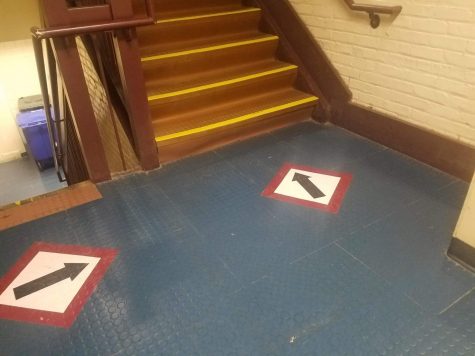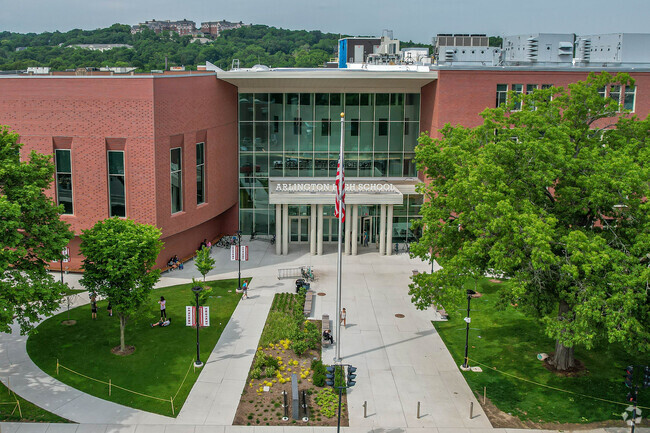Ottoson Middle School to Return Full-Time: Plans and Student Opinions
Face masks are required on Ottoson property to reduce the spread of COVID-19//Photo credit Sofia Lay
April 3, 2021
On Tuesday, March 9th the state of Massachusetts (MA) announced that middle school students across the Commonwealth must return to school full-time as soon as April 27. This decision comes after over a year of students engaging in hybrid or remote learning, with some students never having stepped foot in a school building since March 2020. Arlington, which provided both hybrid and remote options this year, has been working on the logistics of accommodating a full school building per Massachusetts guidelines.
In an eight-to-three vote, the MA Board of Education voted to return students to school full-time, pressuring districts to send children back to the buildings in the next couple of months. The state has made it clear that remote and hybrid learning models would no longer count towards the required number of student learning hours. However, in an email sent to families on March 7th, Superintendent Bodie stated that students who selected fully remote programs have the option to remain at home for the rest of the school year. Although this fully-remote learning model remains an option, for now, the Superintendent also specified that next year all students are expected to attend in-person school full-time.
At Ottoson Middle School, a plan has been put into place to keep students safe. New adjustments, such as the reduced spacing of desks to three-feet-apart, are intended to accommodate more students. With more students and both virtual and in-person classes becoming fully in-person, many schedule changes were necessary. The first major change would be the mixing of clusters. While in-person classes were previously only mixed within clusters, incorporating certain classes that have been all-remote since September means that mixing is now necessary. Electives and non-core classes such as ACE (Academic Challenge and Enrichment), computer science, band, chorus, and orchestra would be affected. Other changes include the transition to a seven-period day, as opposed to the current six-period schedule. Physical Education (PE) classes will be changed so that students will be with only students from their same cluster, to simplify contact tracing and limit exposure. This could potentially cause a student’s PE teacher to change.

Although the State Board of Education encouraged schools to return fully in-person, students are concerned for their learning. “I just don’t really see the point in it. I think that the schedule we’re in now can work for the rest of the year, and we should just keep it like that,” one Ottoson student explained in a recent poll. This anonymous seventh-grade hybrid learner continued to elaborate. “For me at least, [returning full-time] would make learning harder instead of easier. There are probably other students that feel that way too.” The student’s fellow peers are voicing similar worries. An eighth grader who is in the hybrid program explained that “the prospect of going back full-time is stressful.” In a recent poll, 60% of participants asserted that the learning environment and social aspects of the transition are the most upsetting part of this sudden change. Many students believe that the school will take care of their health and COVID safety, but new schedules and changed social dynamics are a source of stress.
Although COVID safety was not the primary concern in the survey, some were eager to share their worries about cleaning and social distancing precautions. “There would be less social distancing and more people in a classroom, which increases the chance of COVID-19 spreading,” explained an eighth grader. Others were likewise uneasy about the distancing issue with increased numbers of people in the school building. One eighth grade hybrid student felt very strongly that we should not integrate the two cohorts. They stated that their primary emotions about a full return are anger and sadness, expressing that the state’s determination would lead to “more kids getting sick” and that it was altogether “a bad decision.” In a recent interview, Ron Sliney, a custodian at the Ottoson School building, explained that custodians will do their best to keep everyone safe. “[School custodians are] going to continue spraying contact points such as door handles,” Sliney remarked. “If we see students standing too close together, we’ll tell them to distance a bit.”
While students, parents, and staff are torn on whether the decision to return to school full-time was the right one, groups across Massachusetts have written an open letter urging Governor Charlie Baker to delay reopenings. While no statement has been made by the Governor, students, teachers and parents all await the verdict on whether schools will be allowed to reopen after all.









